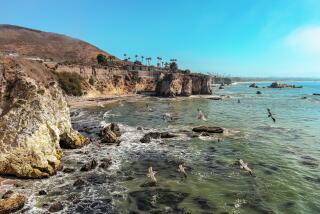Wetlands Preserve : Audubon Society to Restore Bird Habitat
- Share via
The major habitat restoration of Ballona Wetlands, an integral part of the proposed community of Playa Vista, can be expected to flourish under the auspices and long-term commitment of the National Audubon Society.
The transformation, however, will not occur overnight. The process is too delicate to be rushed.
The National Audubon Society was chosen by Howard Hughes Properties to own and manage the 209-acre habitat and will receive $10 million from Hughes for restoration and permanent management of the Ballona Wetlands area, through its Western Regional office.
Glenn Olson, the society’s regional vice president, said the restoration will require that the work be done in scientifically designed phases in order for the ecosystem to mature and stabilize.
The project, located southeast of Marina del Rey and north of Westchester, is expected to mature within about 10 to 15 years. It will cover 175 acres of salt marsh, intertidal mud flats, subtidal channels, freshwater marsh, a riparian stream corridor and 34 acres of adjacent buffer, sand dunes and bluffs.
“We’ll be increasing the water on the site and the tidal interchange and we will supplement the freshwater supply by increasing the number of pipes that connect the wetlands to the Ballona and Centinela creeks’ flood control channels,” explained Eric Metz, Audubon’s manager for the project.
Another aspect of the restoration, he added, will be the revegetation of the bluffs with native coast scrub and planting of salt pickleweed. “It will help to entice more waterfowl than currently use the marsh, and to attract other freshwater dependent species that would include frogs, turtles, lizards, snakes and insects.”
In coming years, visitors to the area will have an opportunity to visit Audubon’s proposed “living museum” designed to educate the public on the values of wetlands in general, Olson said. “Wetlands teem with life and are among the earth’s most productive environments.
“Future vistas will reveal an attractive landscape with meandering channels, trees and shrubs and broad flats covered with shore birds such as the common American white egrets, the great blue herons, ducks, and will help protect endangered species such as the California least tern and Belding’s savannah sparrow,” he said. “The marsh is a necessary stopping point for migrating birds.”
Initial costs for improving the environment have been estimated at about $6 million, Metz stated, and funding for the interpretive center will probably come from public and private sources.
“We plan to install a system of trails and bird viewing and to develop special programs and exhibits so that people can better appreciate and understand this diminishing resource,” he added.
The Audubon Marsh at Ballona Creek is one of the last remaining tidal marshes in Southern California.
More to Read
Sign up for Essential California
The most important California stories and recommendations in your inbox every morning.
You may occasionally receive promotional content from the Los Angeles Times.










